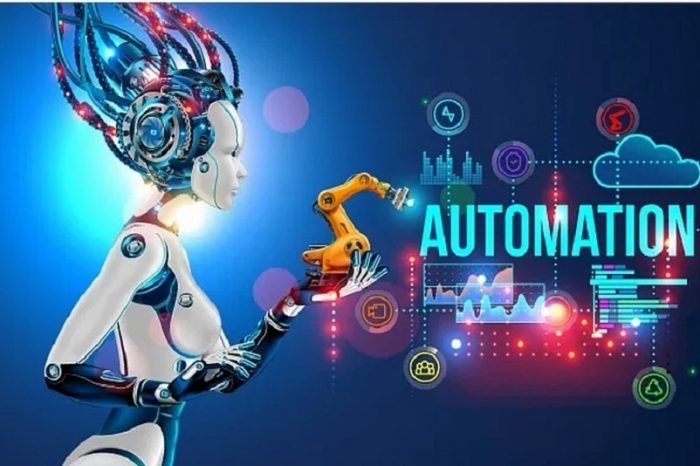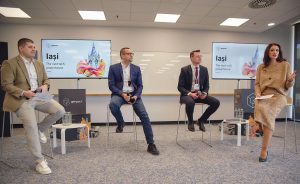Six trends in information technology in the next 3 years

Author: Sabina Amaricai, Qualinest founder and software testing architect
In 2021 the global information technology (IT) industry is projected to reach a value of USD 5 trillion. As the industry is on the rise and new innovations and tech developments are announced daily, the IT market will be dominated in the next 3 years by technologies such as: artificial intelligence, augmented reality, blockchain and internet of things, as well as an increased demand for cybersecurity.
- The global artificial intelligence market was valued at USD 29.86 Billion in 2020 and is estimated to reach USD 299.64 Billion by 2026, at a compound annual growth rate (CAGR) of 35.6% during the forecast period of 2021-2026.[1]
- Artificial intelligence is not the only sector on the rise. The global augmented reality market size is projected to increase from a value of USD 17.67 billion in 2020 to USD 340.16 billion by 2028, at a CAGR of 43.8% from 2021 to 2028.[2]
- Moreover, it is estimated that the Internet of Things market size will reach USD 1,854.76 billion by 2028, at a CAGR of 25.4% during the forecast period of 2021-2028.[3]
Sabina Amaricai, Qualinest founder and software testing architect delves into the 6 trends that will define the IT industry in the next 3 years.
- Artificial Intelligence and Robotic Process Automation
You can now focus on what really matters to you. AI and RPA will handle your routine tasks.
Compared to traditional system, AI and RPA are evolved technologies – the next step. What is so special about them that they don’t follow a predicted set of rules. Because they are “smart”, they have the ability to extrapolate behaviours and example patterns in order to establish their next step.
They can be used them in automation of repetitive human tasks – since they can predict changes in patterns and analyse data received nearly real time. A machine can test an application, for example, by learning the user’s behaviour.
It does sound promising.
But the truth is that using a machine doesn’t necessarily lead to a flawless result. It can be prone to failure as well, because it depends on the set of data available.
Remember the Uber self-driving car experiment? It didn’t predict people jaywalking, because this edge case scenario was simply not in the input data. That’s why you need to define comprehensive sets of data and dedicated quality processes before thinking that automation saves the day.
- Virtual Reality and Augmented Reality – education and medical fields enhanced
You can be watching a theatre play like Phantom of the Opera while feeling like you are in La Scala, in Milan and definitely not in your living room. You can enjoy trying out new outfits without putting up with the crowded fitting rooms from your favourite stores. You can have the same morning run routine, with perfectly curated view and weather.
Augmented reality is available for all prices and new levels, as these technologies are continuously developing, aiming to enhance your day-to-day life.
But there is more. We are so close to using these technology advancements not just for entertainment, but for medical treatments and diagnosis as well. Also, it can bring education and learning to new levels, for all kinds of learners – from young children to adults of all ages.
There is obviously a need for experienced professionals in all areas of Information technology.
Those who understand how to work with, and not against the machines. Those who add their human creativity to the machine’s processing power. Those who the machines predictability to limit the human errors. That is best from both worlds.
- The Internet of things – or internet for our world.
- Our homes, appliances, our cars and so many other ‘things’ are now “online”
Internet is no longer designed for your laptop or your phone.
Our homes, with utilities and appliances, our gadgets and our vehicles are now connected to the internet. We can control them with our phones from a different location.
You can schedule them to your convenience – to make sure your house is clean and your cup of coffee warm by the time you are back from the office.
The future is now and it looks interesting. Because now, the stakes are higher than in the old days, when we used the internet only on our laptops and phones, the security measures and the proper functionality of ‘things’ become more important.
- Blockchain
Blockchain is currently used with Bitcoin and, as you might know, its major advantage is the fact that its data cannot be lost or changed. It cannot be altered in any way.
Banks could benefit a great deal using blockchain. Imagine how this can impact your financial data!
How about the real estate domain? Tracing all the real information about a property you want to rent or buy? And the price history!
There are so many areas where preventing loss or data manipulation is crucial! Where blockchain would add amazing benefits!
What we should still consider is the generation and sanitization of stored data, as part of the various implementations using blockchain. Experienced engineers are in high demand here as well.
- Mobile applications
“We’ve Spent 1.6 Trillion Hours On Mobile So Far In 2020”, according to Forbes.
The usage of the mobile phones has increased last year, partially due to Covid. But it’s not likely for that number to decrease considerably in the future. We have all we need on our phones – from social media, games, books and podcasts, to our banking applications and healthy habits tracker. They are smart and they use fingerprint or face recognition to log us into anything we need, saving us from remembering even our passwords.
It is fair to say that people will focus on developing new and more innovative apps on mobile technologies, for a good while. Because we enjoy having the world in our pockets – and this doesn’t come challenge free for the developing companies. We want cooler apps, and we want them to work faster and better. To keep up with customers’ increasing demand, the need for highly skilled engineers only gets bigger.
- Cybersecurity
I wanted to mention it at the end, because while it is a standalone trend, it is part of all the other trends as well.
The more digital we become, the more open we are to a cyber-attack. And this is true for all of the trends mentioned above.
Cybersecurity is a concept that is both machine and human generated. We can increase network security, application security, we can add firewalls and various authentication security measures. But what we can’t avoid or bypass is the most important factor of all – the human nature.
It becomes essential to define processes and then to enforce them by guidelines, proper training and intelligent automation. That is the smart, efficient way to increase the security of our systems and our data.
[1] https://www.globenewswire.com/en/news-release/2021/06/28/2253975/0/en/Global-Artificial-Intelligence-Market-Size-2021-Rise-at-35-6-CAGR-Will-Grow-to-USD-299-64-Billion-by-2026-Facts-Factors.html
[2] https://www.grandviewresearch.com/press-release/global-augmented-reality-market
[3] https://www.fortunebusinessinsights.com/industry-reports/internet-of-things-iot-market-100307












